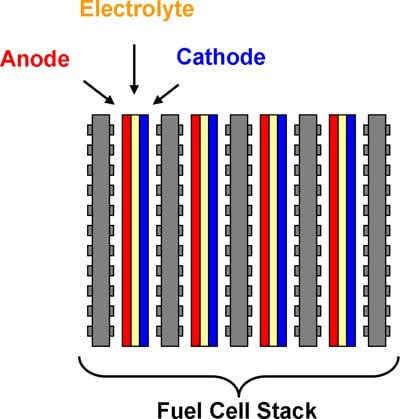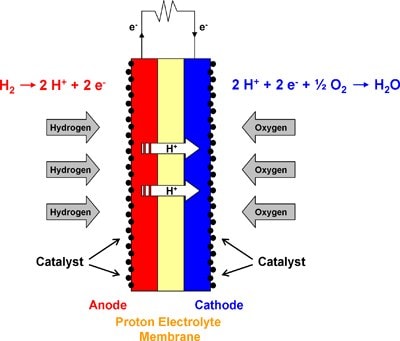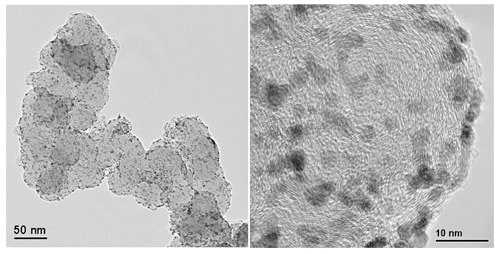质子交换膜(PEM)燃料电池
简介
燃料电池是通过氢气(或富氢燃料源)和氧气反应产生电能的替代能源技术。相对于传统内燃机,这类器件效率高、排放低,产生的废产物仅有热量和水,因而备受关注。开发具有更高性能和成本效益的新型组件材料是新兴燃料电池研究的关键部分。
本页重点关注可在相对较低的温度(~ 80℃)下工作的质子交换膜 (PEM) 燃料电池(也称为聚合物电解质膜燃料电池)材料。了解高温燃料电池的更多信息,请访问我们的 固体氧化物燃料电池(SOFC)技术聚焦。
燃料电池组份
燃料电池装置通常由串联形成电堆的多个燃料电池组成(图1),从而增加了总电量。每个单独的燃料电池包含三个主要组件:两个电极(阳极、阴极)和导电电解质。对于PEM燃料电池,每个电极由浸有电催化剂(通常为铂或铂合金)的多孔高比表面积材料构成。电解质材料是聚合物膜,并且用作离子导体。1
燃料电池中电的产生由两个主要化学反应驱动(图2)。对于以纯H2工作的燃料电池,氢气在阳极电解成质子和电子。质子通过电解质膜传导,电子在膜周围流动,产生电流。带电离子(H+和e-)在阴极和氧结合,产生水和热。2

图 1.由多个燃料电池组成的电池组示意图。

图 2.PEM燃料电池的主要组份和电化学反应示意图。
燃料电池催化剂
铂对氢氧化具有很高的活性,仍然是常用的电催化剂材料。燃料电池研究的一个主要领域是降低铂含量,同时不会降低电池性能,从而提高装置的整体成本效益。3这可以通过使用由铂纳米颗粒制造、承载在导电碳(货号738581、738549和738557)上的工程化催化剂来实现。这些材料的优点在于纳米颗粒的分散度高(图3)、电催化比表面积 (ESA) 高、高温下颗粒生长慢 - 甚至是在Pt负载量较高的情况下。
含Pt的合金适用于以甲醇或重整气(H2、CO2、CO和N2)等专用燃料源工作的装置。例如,相对于纯Pt电催化剂,Pt/Ru 合金在甲醇氧化和一氧化碳中毒方面的性能提高。4 Pt3Co是感另一种目标催化剂(特别是用于PEMFC阴极),对氧还原反应的性能强,稳定性高。5

图 3.Pt/C催化剂(左)和Pt3Co/C催化剂(右)的代表性TEM图,示出了高比表面积碳载体上高度分散的纳米颗粒。
材料
如要继续阅读,请登录或创建帐户。
暂无帐户?